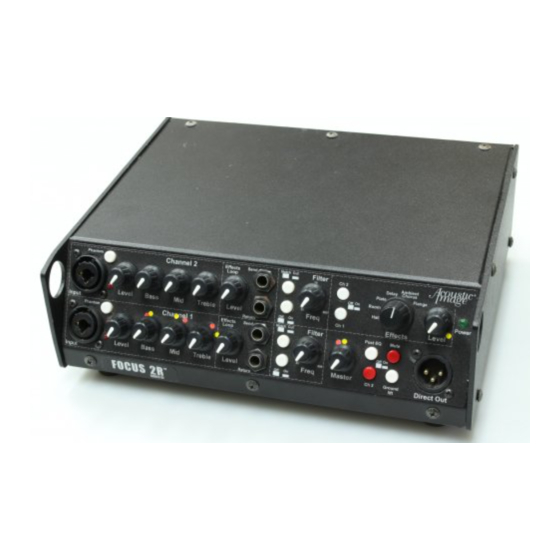Acoustic Image Clarus 2R Owner's Manual - Page 4
Browse online or download pdf Owner's Manual for Amplifier Acoustic Image Clarus 2R. Acoustic Image Clarus 2R 8 pages.

notch/low cut filter in each channel and a master level control that affects
both channels.
Level
The input level controls the level of the signal at the input stage of the preamp.
The master volume controls the level of the signal at the output of the preamp
(at the input of the power amp). Set the master control at "12 o'clock" and the
input level at zero. The input level should then be used to control the overall
output of the unit. The two controls are provided to allow independent control of
"house" volume and "stage" volume when the unit is used on stage with a
connection to a house PA. See the discussion under "Direct Out" below.
Tone
Each tone control has a center detent at the flat position. Experiment with
settings to achieve the frequency balance that sounds best to you. In general,
small values of boost and cut are best. The amp is designed with flat frequency
response so only minor corrections should be required to compensate for room
effects or "peaky" pickups in order to maintain the balanced response desired
for acoustic instrument amplification. To minimize electronic noise, avoid
operating all controls simultaneously at their maximum settings.
The bass control is a shelving-type that affects frequencies below 250 Hz and
with a maximum boost/cut of 15 dB. The mid control affects frequencies
between 300 Hz and 2000 Hz and has a maximum boost/cut of 15 dB. The
treble control is also a shelving-type that affects frequencies above 1000 Hz
with a maximum boost/cut of 25 dB.
Notch/Low Cut Filter
The notch/low cut filter is a fixed amplitude, variable frequency type that inserts
either an 18 dB cut or a 12 dB per octave rolloff at frequencies between 30 and
800 Hz, depending on the position of the control. Approximate frequency
settings are noted on the frequency control. Note that the first half of the
control's rotation affects frequencies from 30 to 70 Hz, the last half of the
rotation affects frequencies between 70 and 800 Hz. This is done so that there
is plenty of control in the critical low frequency range. The notch filter is used to
remove a given feedback frequency to reduce feedback "howl". The low cut
filter is used to reduce the bass output in cases where room location or
instrument/pickup combination results in "boomy" sound. To use either, push
the on/off switch to turn on the filter circuit then select the filter type using the
notch/cut switch. Start with the control fully counterclockwise and gradually
turn it clockwise until the desired effect is achieved. Experiment with the
position of the control to give you the sound you like best.
Effects Loop
Acoustic Image preamps have output ("Send") and input ("Return") capability
in each channel to allow you to use effects boxes. The send output is affected
by the input volume and tone controls and can also be used as a preamp output
for driving other power amplifiers. The Return input can be used to directly
3
Phantom power
XLR
input
¼ inch
Input
input
buffers
Combo jack
Signal Flow Diagram
Effects
Send
Phantom
Loop
Level
Bass
Mid
Treble
Level
Input
Return
Clarus 1 and Focus 1 Control Panel
4
Preamp
Ch 2 input, EQ and filter
(same as Ch 1 below)
3 band EQ
Bass
Mid
Treble
Pre EQ
outputs
Input
level
Power
Notch Cut
Filter
Post
Mute
EQ
70
Off On
30
800
Freq
Master
Off
On
Ground
lift
Direct Out
Filte
Notch
Cut
N/C Switc
Filter
switch
